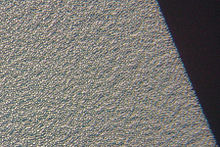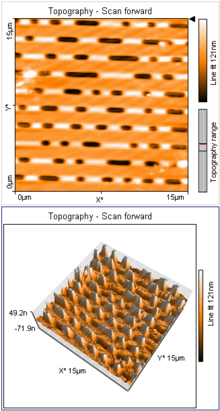- Red Book (CD standard)
-
Compact Disc Digital Audio 
Media type Optical disc Encoding 2 channels of LPCM audio, each signed 16-bit values sampled at 44100 Hz Capacity up to 74–80 minutes (up to 24 minutes for mini 8 cm CD) Read mechanism 780 nm wavelength semiconductor laser Standard IEC 60908 Developed by Sony & Philips Usage Audio storage Optical discs Optical media types - Blu-ray Disc (BD): BD-R, BD-RE
- DVD: DVD-R, DVD+R, DVD-R DL, DVD+R DL, DVD-R DS, DVD+R DS, DVD-RW, DVD+RW, DVD-RAM, DVD-D, DVD-A, HVD, EcoDisc
- Compact Disc (CD): Red Book, CD-ROM, CD-R, CD-RW, 5.1 Music Disc, SACD, Photo CD, CD Video (CDV), Video CD (VCD), SVCD, CD+G, CD-Text, CD-ROM XA, CD-i
- Universal Media Disc (UMD)
- Enhanced Versatile Disc (EVD)
- Forward Versatile Disc (FVD)
- Holographic Versatile Disc (HVD)
- China Blue High-definition Disc (CBHD)
- HD DVD: HD DVD-R, HD DVD-RW, HD DVD-RAM
- High definition Versatile Multilayer Disc (HD VMD)
- VCDHD
- GD-ROM
- MiniDisc (MD) (Hi-MD)
- Laserdisc (LD) (LD-ROM)
- Video Single Disc (VSD)
- Ultra Density Optical (UDO)
- Stacked Volumetric Optical Disk (SVOD)
- Five dimensional disc (5D DVD)
- Nintendo optical disc (NOD)
Standards - SFF ATAPI/MMC
- Mount Rainier (packet writing)
- Mount Fuji (layer jump recording)
- Rainbow Books
- File systems
See also Red Book is the standard for audio CDs (Compact Disc Digital Audio system, CDDA or CD-DA). It is named after one of the Rainbow Books, a series of books (bound in different colors) that contain the technical specifications for all CD and CD-ROM formats.
The first edition of the Red Book was released in 1980 by Philips and Sony;[1][2] it was adopted by the Digital Audio Disc Committee and ratified as IEC 60908 (published in 1987[3]). The second edition of IEC 60908 was published in 1999[4]) and it cancels and replaces the first edition, amendment 1 (1992) and the corrigendum to amendment 1. The standard is not freely available and must be licensed from Philips.
Contents
Red Book audio specifications
The basic specifications state that
- Maximum playing time is 79.8 minutes [5]
- Minimum duration for a track is 4 seconds (including 2-second pause)
- Maximum number of tracks is 99
- Maximum number of index points (subdivisions of a track) is 99 with no maximum time limit
- International Standard Recording Code (ISRC) should be included
Technical details
 The pits in a CD are 500 nm wide, between 830 nm and 3,000 nm long and 150 nm deep.
The pits in a CD are 500 nm wide, between 830 nm and 3,000 nm long and 150 nm deep.
The Red Book specifies the physical parameters and properties of the CD, the optical "stylus" parameters, deviations and error rate, modulation system (eight-to-fourteen modulation, EFM) and error correction (cross-interleaved Reed-Solomon coding, CIRC), and subcode channels and graphics.
It also specifies the form of digital audio encoding: 2-channel signed 16-bit Linear PCM sampled at 44,100 Hz. This sample rate is adapted from that attained when recording digital audio on a PAL (or NTSC) videotape with a PCM adaptor, an earlier way of storing digital audio.[6]
An audio CD can represent frequencies up to 22.05 kHz, the Nyquist frequency of the 44.1 kHz sample rate.
The audio bit rate is 1,411.2 kbit/s:
- 2 channels x 44,100 samples per second per channel × 16 bits per sample = 1,411,200 bit/s = 1,411.2 kbit/s.
As each sample is a signed 16-bit two's complement integer, sample values range from −32768 to +32767.
On the disc, the data is stored in sectors of 2352 bytes each, read at 75 sectors per second. Onto this the overhead of EFM, CIRC, L2 ECC, eight subcode data channels, and so on, is added, but these are not typically exposed to the application reading the disc. Because of this overhead, the raw bitrate (at the optical pickup) is considerably higher than the audio bitrate.
By comparison, the bit rate of a "1x" data CD is defined as 2048 bytes per sector × 75 sectors per second = 150 KiB/s (1228.8 kbit/s), or approximately 9.2 million bytes per minute.
Format Deviations
Some major recording publishers have begun to sell CDs that violate the Red Book standard. Some do so for the purpose of copy prevention, using systems like Copy Control.
Some do so for extra features such as DualDisc, which includes both a CD layer and a DVD layer whereby the CD layer is much thinner, 0.9 mm, than required by the Red Book, which stipulates a nominal 1.2 mm, but at least 1.1 mm. Philips and many other companies have warned them that including the Compact Disc Digital Audio logo on such non-conforming discs may constitute trademark infringement. Either in anticipation or in response, recent copy-protected CDs bear stickers and warnings that the CD is not standard and may not play in all CD players, and no longer display the long-familiar logo.
In the beginning of the 21st century, two advanced versions of the audio CD emerged: the Super Audio CD and DVD Audio. The two rival formats were designed to feature audio of higher fidelity. Both formats apply a higher sampling rate and use 650 nm lasers.
Availability
The standard is available from Phillips and the IEC. As of 2004, the cost per the relevant Philips order form [7] is US$5,000. As of 2009, the IEC 60908 document is available as a PDF download for US$260.[8]
See also
- Extended Copy Protection—source of the Sony DRM scandal
- DRM (computing)
- Four-channel compact disc digital audio
- WAV
References
- ^ "How the CD was developed". BBC News. August 17, 2007. http://news.bbc.co.uk/2/hi/technology/6950933.stm. Retrieved 2007-08-17.
- ^ "Philips Historical Products – Philips Compact Disc". http://www.philipsmuseumeindhoven.nl/phe/products/e_cd.htm. Retrieved 2010-10-06.
- ^ IEC 60908 ed 1.0 - IEC search, http://www.iec.ch/dyn/www/f?p=103:105:0::::FSP_SEARCH_ORG_ID,FSP_SEARCH_AND,FSP_SEARCH_QUOTE,FSP_SEARCH_OR,FSP_SEARCH_NONE,FSP_SEARCH_DOCREF,FSP_SEARCH_STAGECODE,FSP_SEARCH_HEAD,FSP_SEARCH_PUBPROJREF,FSP_SEARCH_DATERANGE,FSP_SEARCH_DATEFROM,FSP_SEARCH_DATETO,FSP_REQUEST:%2C%2C%2C%2C%2C%2C%2C%2C60908%2C0%2C%2C%2C5, retrieved 2011-07-28
- ^ IEC (PDF), IEC 60908 ed. 2.0 - preview, http://webstore.iec.ch/preview/info_iec60908%7Bed2.0%7Db.pdf, retrieved 2011-07-28
- ^ Clifford, Martin (1987). "The Complete Compact Disc Player." Prentice Hall. p. 57. ISBN 0-13-159294-7.
- ^ 2-35] Why 44.1KHz? Why not 48KHz?
- ^ Document no. 28/10/04-3122 783 0027 2
- ^ IEC 60908 Ed. 2.0 b:1999 Audio recording – Compact disc digital audio system
External links
- Philips' Audio Standards licensing info
- IEC 60908 publication info
- MultimediaWiki article about PCM and Red Book CD Audio
Red Book (CD Digital Audio) · Yellow Book (CD-ROM and CD-ROM XA) · Orange Book (CD-R and CD-RW) · White Book (Video CD) · Blue Book (Enhanced CD, CD+G and CD-Plus) · Beige Book (Photo CD) · Green Book (CD-i standard)Categories:- Optical disc authoring
- Rainbow Books
- Audio storage
- IEC standards
- 1980 works
- Joint ventures
Wikimedia Foundation. 2010.

